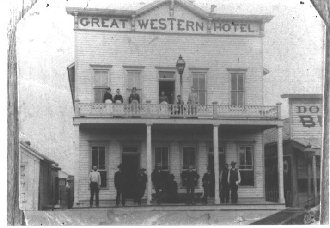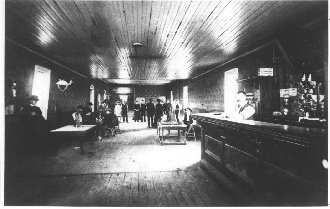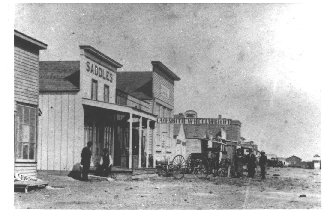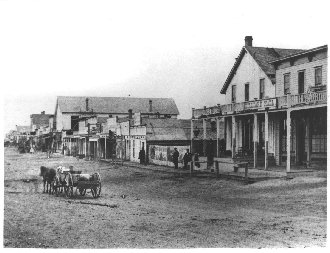Front Street, Dodge City, KS 1876
Dodge City
is a pure definition of the West....a gateway to history
that began with the opening of the Santa Fe Trail by William
Becknell in 1821 and became a great commercial route between Franklin,
Missouri and Santa Fe, New Mexico until 1880. Thousands of wagons
traveled the Mountain Branch of the trail which went west from
Dodge City along the north bank of the Arkansas River into Colorado. For
those willing to risk the dangers of waterless sand hills, a shorter
route called the Cimarron Cutoff crossed the river near Dodge
City and went southwest to the Cimarron River.
In those days, safety from marauding Indians was essential.
Fort Dodge was established in 1865 on the Santa Fe Trail near
the present site of the city, offering protection to wagon trains,
the U.S. mail service and serving as a supply base for troops
engaged in the Indian Wars.Kiowa,
Cheyenne and other plains tribes inhabited the area and wild game was abundant including
vast herds of Buffalo.
|
Just six years later in 1871, five miles east of the Fort at the
foot of a hill along the Trail, a rancher by the name of Henry
L. Sitler constructed a three-room sod house. Built to oversee
his cattle ranch, Sitler's home became a frequent stopping place
for buffalo hunters and traders. Dodge City was founded the next
year, 1872, just five miles west of Fort Dodge on the edge of
the military reservation, with the Sitler's home as the first
building. It quickly became a trade center for travelers and Buffalo
hunters.

Great Western Hotel, South Dodge City, KS ca. 1880
By September of 1872, the shiny steel rails of the brand new Atchison,
Topeka and Santa Fe railroad stretched into view. And a town was
waiting. The railroad initiated a tremendous growth for many years.
Already, south of the tracks, hastily built frame buildings and
tents were housing two grocery and general merchandise stores,
a dance hall, a restaurant, a barber shop, a blacksmith shop -
even a saloon next to Sitler's original sod house. The famous
Front Street legend had begun. Dodge City was already setting
a record for growth.
Stacks of Buffalo hides towered along Front Street - filthy Buffalo
hunters and traders filled the town's establishments - and the
term "stinker" was coined. Train-masters would take their
red caboose lanterns along when visiting the town's "soiled
doves" - and the term "red light district" came
to life.
But during those early years, Dodge City also acquired its infamous
stamp of lawlessness and gun-slinging. There was no local law enforcement
and the military had no jurisdiction over the town. Buffalo hunters,
railroad workers, drifters and soldiers scrapped and fought, leading
to the shootings where men died with their boots on. And that
created a hasty need for a local burial place - Boot Hill Cemetery.
The cemetery is now a part of downtown Dodge City. It was
used until 1878. For six years before Boot Hill, Dodge City had
no official cemetery. Persons dying who had friends, enough money
or sufficient standing in the community were buried in the post
cemetery at Fort Dodge. Others, penniless or unknown, were buried
where it was convenient to dig a hole.

Charles Rath sitting on a pile of buffalo hides. Rath
owned Rath & Co., a general outfitting store. He also shipped hides east. This yard held up
to 70,000 hides at the time.
Dodge City was the Buffalo capital for three years until mass
slaughter destroyed the huge herds and left the Prairie littered
with decaying carcasses. An estimated 850,000 Buffalo hides were
shipped from Dodge City in the years 1872-1874. Farmers, during
hard times, gathered the Buffalo bones and sold them for six to
eight dollars a ton. The bones were used in the manufacture of
china and fertilizer. By 1875 the Buffalo were gone as a source
of revenue, but the Longhorn cattle of Texas drove the dollars
into town. For ten more years, over five million head were driven
up the western branch of the Chisholm and Western Trails to Dodge
City. Law and order came riding into town with such respectable
officers as Bat Masterson, Wyatt Earp, Bill Tilghman and
Charlie Bassett. Out of these personalities evolved the
famous fictional character of Marshal Matt Dillon. The
town these early men knew was laid out with two Front Streets,
one on either side of the railroad tracks.
The city passed an ordinance that guns could not be worn or carried north of the
"deadline" which was the railroad tracks. The south side where "anything
went" was wide open. In 1876 the population was 1,200 and nineteen businesses were
licensed to sell liquor.

Ham Bell's Variety. A saloon south of
the infamous "Dead Line"
During those first years the population varied according to the
season, swelling during the summer with the influx of Cowboys,
Buyers, Gamblers and Prostitutes. Business houses, dance halls
and saloons catered to the Texas trade. Saloon keepers renamed
their places, Alamo and Lone Star and served brandies,
liqueurs and the latest mixed drinks. Ice usually was available
so even beer could be served cold. Some saloons advertised anchovies
and Russian caviar on their cold menus. Gambling ranged from a
game of five cent "Chuck-aluck" to thousand dollar poker
pots. Many saloons offered some type of musical entertainment -
a piano player, a singer, or as in Chalk Beeson's Long Branch,
a five piece orchestra. Beeson also organized and led the famous
Cowboy Band which entertained all over the west at cattlemen's
conventions, concerts, dances and in Washington, D.C. at the inauguration
of President Harrison.

Front Street, Dodge City, KS ca. 1880
Fort Dodge was closed in 1882 and by 1886, the cattle drives had
ended. An illustrious period of history was over but the legend
lives on in Dodge City's historic preservation of its romantic
and internationally famous past.
As the nineteenth century ended, the bragging of the western pioneer
furnished an abundance of materials for dime novels, nickelodeons,
Hollywood films, radio and television. Even today, over 100,000
tourists relive the legend each year by visiting the Boot Hill
Museum and historic Front Street reconstruction. "If the
history of the West has been a mother lode of entertainment riches,
Dodge City has been its touchstone."
Courtesy Nancy Trauer, Dodge City Convention & Visitors Bureau,
P.O Box 1474, Dodge City, Kansas 67801 - Tel (316) 225-8186
Photo Courtesy Boot Hill Museum, Front Street, Dodge City, Kansas 67801 Phone (316) 227-8188.
This is the museum you must visit to learn more about Dodge City's experiences during
the Old West.
Boot Hill Museum (located at the old cemetery site) receives more than 100,000 visitors annually.
Hollywood movies made on the subject:
Dodge City (1939)
Errol Flynn,
Olivia de Havilland
,
Ann Sheridan.
The Gunfight at Dodge City (1958)
A Big Hand for the
Little Lady (AKA "Big Deal at Dodge City") (1966)
Henry Fonda
Desperadoes of Dodge City (1948)
West of Dodge City (1947)
Vigilantes of Dodge City (1944)
King of Dodge City (1941)
Tex Ritter
Dodge City Trail (1936)
Back




